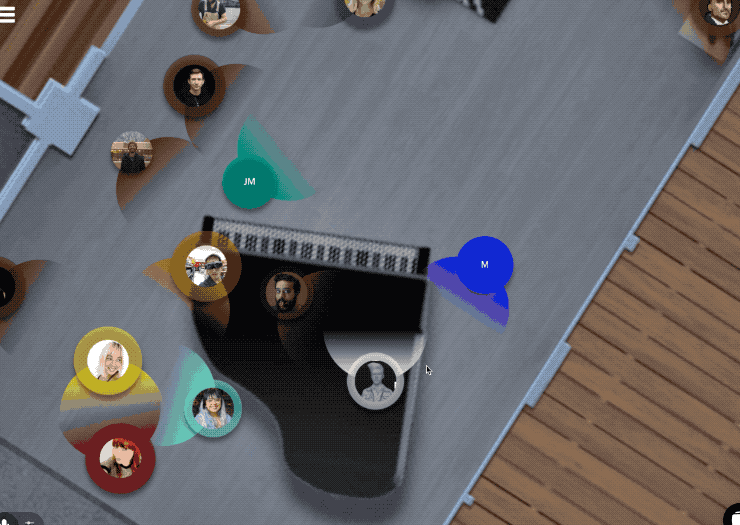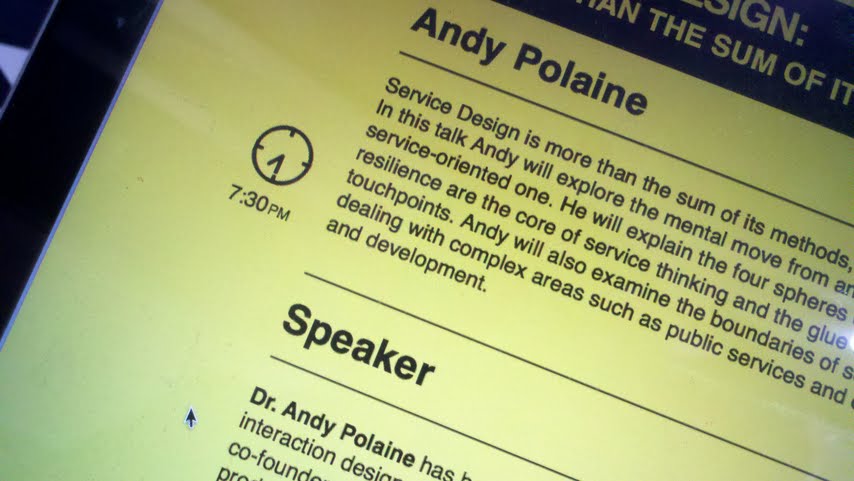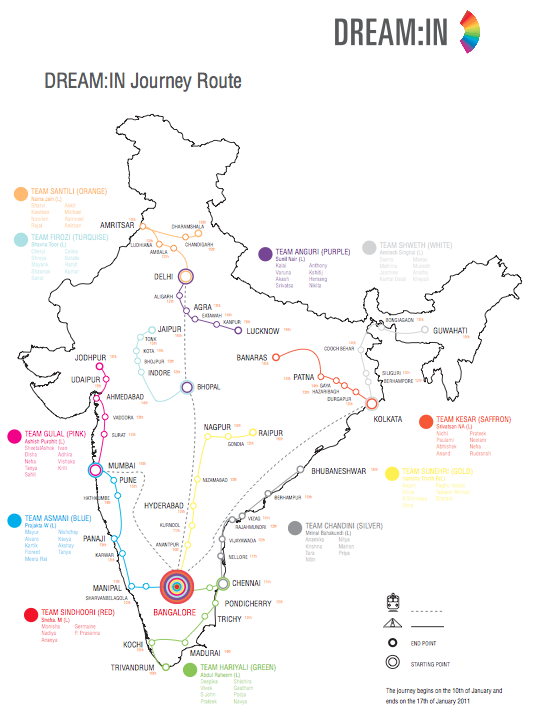Bjarke Ingels spoke at Parsons and presented his amazing works as well as a vision for the future.[singlepic id=646] See chunked notes for details.
Bjarke Ingels
proposing that we're "not designers of 2d or 3d objects" but rather "designers of ecosystems" that
"channel not only the flow of people, but also the flow of resources through economy and ecology."
Hedonistic Sustainability
dragon symbolic of China
swan of Denmark
Comparison between Shanghai and Copenhage
relating Shanghai to Copenhagen, but Shanghai is not your typical Chinese city and has a history of being cosmopolitan with it's large expat community and growth from a port city.
[singlepic id=642]
World Expo
collaboration with Ai Weiwei on the installation of the "Remote" installation for Little Mermaid
-Environment
-temperature, natural airflow "creating a draft"
using evaporative cooling from the pool inside
-Energy
"entire system spent less energy than the coffee machine"
"half art and half architecture" emphasis on how to "increase art quality"
-Tony stark's mad science expo (using a similar image as the first photo of the Danish Pavilion from the world expo)
"If hollywood starts ripping off sustainable architecture," maybe "we're moving towards hedonistic architecture"
Designing for Personas and Psychologies (my words)
You can bike thru the whole thing in 2 minutes w out missing a thing.
It's like desinging for Type A and Type B personalities
[singlepic id=648]
Architects
"Architects are @ the center for [discussing how] to redesign the service of our planet so that it fits the way we want to live"[singlepic id=643]"The public discourse [has architecture] reduced to contemplating the final results"
Maybe it is about process, process to build and post build, process to exist...instead of perish.
He looks at "coming back to the way the building is created for people."
[singlepic id=649]
Yes is more
"Less is more." Mies van der Rohe - minimalistic aesthetic
"Less is bore." -Robert Venturi
"I am a whore and am paid very well for building high-rise building." - Phillip Johnson
[singlepic id=660]
Evolution
"Rather than revolution against society, ... evolution with society"
[singlepic id=669]-Drawing Darwin's evolutionary tree
evolution
"a process of designing through excess in each generation."
"a functional model and beautiful model"
relating each evolutionary iteration to a "design meeting."
subspecies that spin off.
his studios never throw anything out.
it's an archive of architecture biodiversity
you never know when [a previous project can be the answer to something new]
[singlepic id=652]
Architectural Alchemy
Similar to Jason Severs of frog reffering to some clients viewing design as "the dark arts" (see notes), and Valerie Casey of Designers Accord noting “the myth of designers as magicians” (see those notes)
I am seeing that as a theme that keeps popping up in presentations, the mystique behind, or rather infront of, design.
Project in Denmark
"Lively and diverse when you're building a city from scratch"
New York
a vision with "an oasis in the city"
[singlepic id=659]an animation of what New York can look like in the future.
Public Participation
he notes most of his work is private commissions
ex 1: project for the Danish maritime museum
ex 2: city hall in capital of Estonia
[I hear the US Embassy there is a palace.]
[singlepic id=664]
created a "public service marketplace"
-it contained 11 different departments - so they created a prous organizattion
[architecture based off of the organization]
-condensed village of public administration
-the roof "invites the citizens" into what looks like a roof top lounge.
-instead of a tower they proposed a "political reflection"
-containing a giant mirror that shows an overview of the city
-this "democratic parascope." also allows the people outside to see what the politicians are doing inside.
work in Kazakhstan
"linear library - the ideal sturcture"
"so a circle combines linearity with efficiency"
"a continuous loop of public programs warpped around an ideal archive"
the exterior was created to be a mobius strip
somewhat resembling the Yurt of the Kazakhs
the center of which is a coutaryd which is entered before you enter the actual library.
when meeting with the president they saw a work of contemporary art that looked errily like their proposal.
"rational and rigorous argument to create the most compelling argument"
greenlandic national art museum
on the waterfront of Nuuk, the capital city
a loop that receives an imprint of the ground it sits on.
"integrated withe the nature and the topography"
the presnts an "unfoled section" view showing a singley linear view
[realtes to concept of time experienced through a subjective path]
The Big Picture
[singlepic id=667]Loop City
"what we need to do is not focus myopicly on the danish side, we need to focus at the Swedish side.."
"A holistic master plan"
"We can connect the most desnly polulatted part of metroplitant scandifanvia" which also an area under extrem growth."
Binational metropolitan region connecting universities, resources.
[singlepic id=666]"The same size as the San Francisco bay area"
[singlepic id=654]"The train system serves as an an energy spine for charging electric cars" (which are tax free in Denmark costing a 3rd of normal cars)"
Energy infrastructure
Social infrastructure
[singlepic id=655]synergies - ex: excess energy from industry becomes heat for the public baths.
A waste to energy plant
[singlepic id=673]
Since there are extreme sports like race-carting around in the vicinity, BIG proposed a ski resont ontop of the power plant.
You can use normal ski equipment on a to allow for a "hybrid of bikini skiing"
In the winter snow can be "created by blowing air [or moisture] through the system with no energy
expense."
Excess water is drained thru the facaces to fill planters on the windows.
He then presents the initial vision [see fist cellhpone pic] to design cities as ecosystms of buildings.
The chimney smoke isn't toxic, but does have CO2. 1/10ths of a ton of CO2
"One of the main drivers for behavoir change is knowledge."
"If they dont know they cant act."
Pragmatic Utopia
"Economically and ecologically sustainable"
"You make it socially sustainable because it gives the city a public space and social function that would otherwise be nonexistent."
"The vision of future cities."
"Pragmatic utopian master plan for the future."
This is the slide he opened with, as well as the slide he closed with. I think effective presenters plant a seed a the beginning of the talk and then refer back to it at the end. This allow them to loop to a conclusion that you already knew but has grown.
[singlepic id=671]
[singlepic id=672]packed house.
[singlepic id=674]more than 970 slides
More
Bjarke Ingels Group - http://www.big.dk/
Many of his projects he presented you can see on TED.
Other pieces presented:
the parking + apartment peice in Denmark
-"the facade turns into a rasterized image by the holes drilled into the aluminum"
Thoughts
As an architect he looks at multiple domains to develop metrics to create qualitative experiental and places. That is something most service designers don't do very well.
Space is gorgeous, has an emotinal impact.
Service design we don't place emphasis on the changing the physical space.
So there is a need to emphasise the emotion of the experience.
Q's
[singlepic id=657]What more can we do?
How unsustainable Chinese architecture and development is
The emphasis for China to become a consumer culture.
Green Energy in China. [my general Q's to expand on]
Guest Lecture by Bjarke Ingels at Parsons
Original event information:
March 10, 2011 6:30pm
Kellen Auditorium
Sheila Johnson Design Center
66 Fifth Avenue
[singlepic id=640]Thanks to SCE
The MArch program presents a lecture by Bjarke Ingels of BIG- Bjarke Ingels Group. Bjarke Ingels started BIG-Bjarke Ingels Group in 2005 after co-founding PLOT Architects in 2001 and working at OMA in Rotterdam. Through a series of award-winning design projects and buildings, Bjarke Ingels has created an international reputation as a member of a new generation of architects that combine shrewd analysis, playful experimentation, social responsibility and humour. In 2004 he was awarded the Golden Lion at the Venice Biennale for the Stavanger Concert House, and the following year he received the Forum AID Award for the VM Houses. Since its completion, The Mountain has received numerous awards including the World Architecture Festival Housing Award, Forum Aid Award and the MIPIM Residential Development Award. Recently, Bjarke was rated as one of the 100 most creative people in business by New York based Fast Company magazine.
Original event information via: http://sce.parsons.edu/2011/03/04/guest-lecture-bjarke-ingels/
[nggallery id=54]




